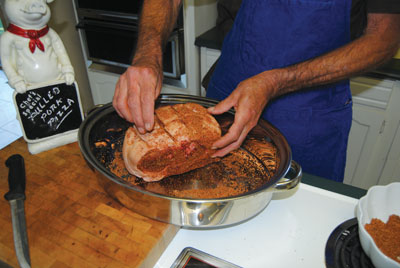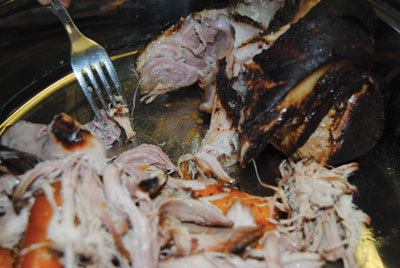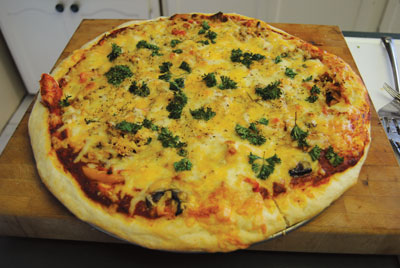
Making pulled pork
By Tony Palermo
Features In the Kitchen RecipesHow to pull off the perfect pulled pork for your pizzas and sandwiches
Who doesn’t love the smoky flavour of southern barbecue?
Who doesn’t love the smoky flavour of southern barbecue? Even if you don’t, all you have to do is look at the lineup of celebrity chefs and popular television shows that celebrate the tastes of this cuisine to see its undisputed popularity.
Pulled pork is a staple in the barbecue world. Its smoky flavour and juicy, tender meat works well in many applications, including pizza.
 |
|
| 1. After scoring the fat side of the roast, generously apply your rub all over the meat, including in between the scored fat. |
|
 |
|
| 2. After cooking the pork and letting it rest, you will find that the meat will flake easily and can be “pulled” in small bits from the main pork roast. |
|
 |
|
| 3. This pulled pork pizza was created by butcher Gary Edwards. As he says, “The idea is to have fun with it and bring some delicious, creative flavours to pizza.” Advertisement
|
The only special piece of equipment you’ll need is a smoker. The prices for smokers vary quite a bit and generally depend on the heating source (charcoal, electric, gas or wood), size, features and brand. But, you don’t need the biggest and greatest smoker to pull off fantastic pulled pork. In fact, the pork for this recipe was smoked using a small, inexpensive, electric smoker, and then finished off in a traditional oven. The beauty of a small, electric unit is you don’t even have to be the king of barbecue to pull off fantastic tasting pulled pork.
This recipe was prepared using a 1.8-kilogram (four-pound) pork shoulder picnic roast. “For pulled pork, you want to use a pork shoulder picnic roast or a pork shoulder butt roast,” says retired butcher and caterer Gary Edwards.
According to Edwards, one of the things you want to look for in choosing the pork is moderate marbling – basically, streaks of fat running throughout the meat. It doesn’t hurt if the pork has a few larger chunks of fat in it either, and you’ll definitely want one side of the roast covered in fat.
“The marbling is going to give the pork some nice flavour and also help to keep it moist,” says Edwards. “And when we go to cook the meat, we’re going to place the fat-covered side facing up. As the meat cooks, the fat will drip down through the inside and outside of the meat.”
Preparing the meat
After placing the pork on a flat surface, fat side up, Edwards scores the fat in a cross-hatch pattern. This serves a couple of purposes: it lets you get right in there and season the meat with your rub, which adds more flavour during the cooking process, and it also helps the fat crisp up.
And now, the most controversial part of the process: should you use a dry rub or a wet rub?
Edwards notes that the choice of which rub to season the meat with is often a personal one (and as a butcher, he’s heard the debates between the two camps throughout the years). His rule of thumb is this: if the meat could use more moisture, Edwards uses a wet rub. Otherwise, if the meat is like the pork being prepared in this recipe – well marbled and being cooked slowly at a low temperature – Edwards prefers to use a dry rub to season the meat.
To season the pork, Edwards alternates between sprinkling the meat with the dry rub, and then massaging it into the meat. He repeats this until the whole roast of pork is completely covered with the rub mixture, making sure that he’s added extra rub in between the cross-hatched cuts he scored into the fat earlier.
Then it’s off to the fridge, where the pork will marinate for a good 12 hours or so, absorbing the delicious spice combination, before being smoked and cooked.
“I marinate smaller cuts of meat in a Ziplock-style bag and leave it overnight,” says Edwards. “Depending on the size of the meat, I’ll let it marinate anywhere from eight to 24 hours.”
Low and slow
The next day, Edwards sets up his smoker and uses a hickory wood flavour base. Hickory is a staple in southern barbecue, but you can experiment with the different woods. As Edwards says, the thing to keep in mind is that you’re looking for hardwoods with a low sap content (the sap will produce a bad flavour).
When using a small home-style smoker unit, Edwards aims for a temperature of between 60 C (140 F) and 66 C (150 F). He’ll let the meat smoke for about two hours, replacing the wood chips after about an hour. The idea at this stage isn’t necessarily to cook the meat through, but to impart a delicious smoky flavour.
“When you’re cooking the pork, you generally want an internal temperature of about 170 to to 180 [F],” says Edwards. “But for pulled pork, I like the meat to be between 195 and 205 F. Most small home smokers can’t reach that temperature, so after smoking the meat for a couple of hours, transfer it to an oven and finish it there.”
After removing the pork from the smoker, Edwards places it in a large dutch oven (a roasting pan will work also), placing the meat fat side up. If required, Edwards uses a couple of whole carrots or other root vegetables to keep the meat seated in this position. He adds enough water to the pan so the water comes up about a quarter-inch from the bottom. Finally, he covers the pan and places it in a preheated 135 C (275 F) oven, where he lets it cook low and slow for several hours, checking periodically to make sure the roast hasn’t run out of water.
Once the pork is done, Edwards lets it rest for about 15 to 30 minutes, giving it the chance to redistribute its moisture throughout the meat.
After the meat has rested, Edwards begins pulling it away and breaking it up into little pieces.
“The meat will flake and just fall apart,” says Edwards. “It’s called pulled pork for a reason. You just pull it apart and it breaks off with no resistance.”
The final step is to add the barbecue sauce base and mix it throughout the pulled meat. Again, Edwards encourages everyone to create one according to their tastes.
For the sake of simplicity and to show that you can be flexible in using other products, Edwards used a commercial, high-quality barbecue sauce to finish off the pulled pork in this recipe. He mixed equal-part portions of barbecue sauce and drippings from the pulled pork roasting pan, which he then reduced and thickened over a low heat before applying it to the pork.
“The idea is to have fun with it and bring some delicious, creative flavours to pizza,” says Edwards. “And, you’ll find the barbecue sauce also makes an excellent dipping sauce, which you can also offer to your customers.”
Print this page